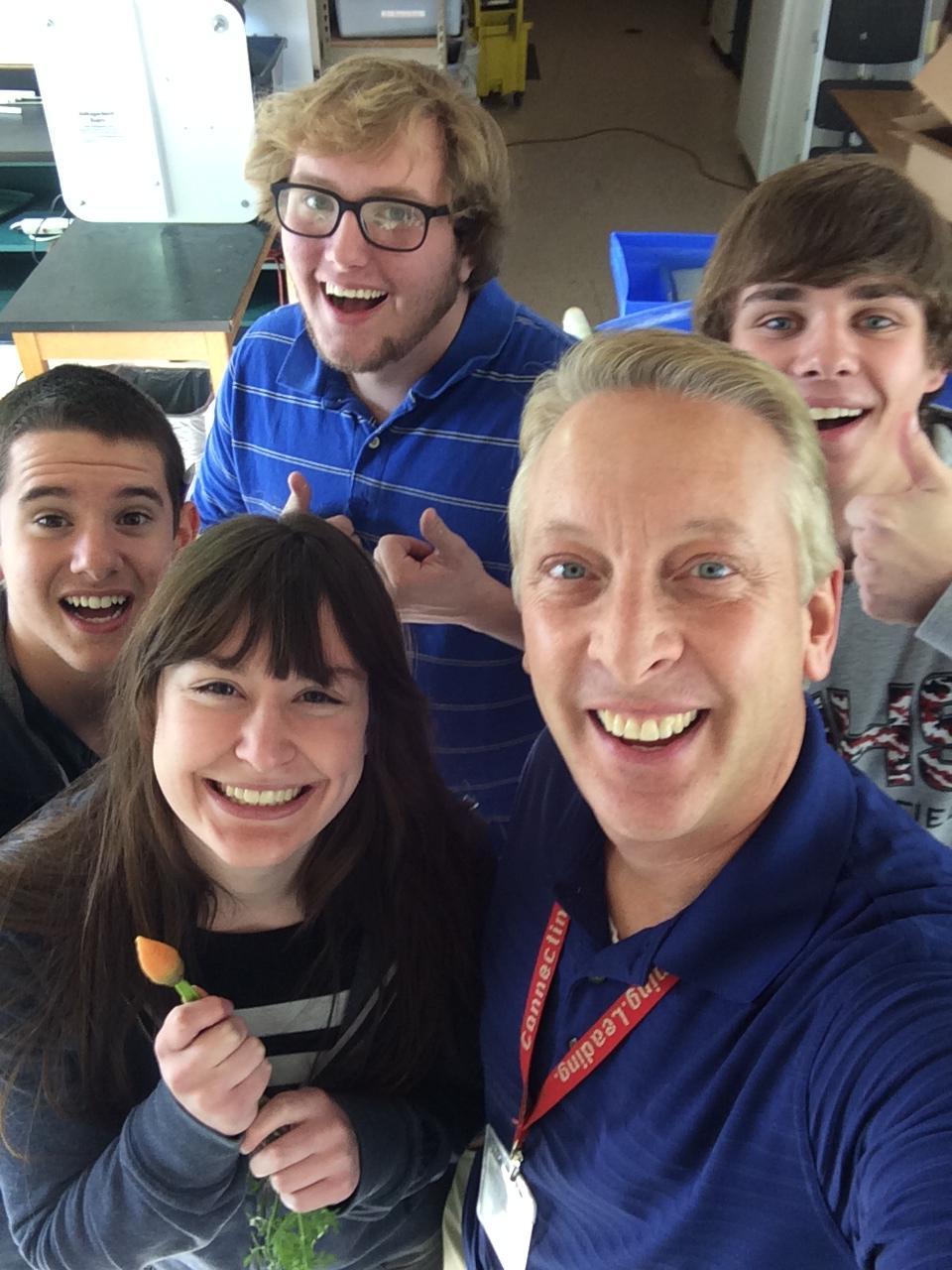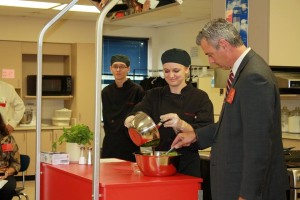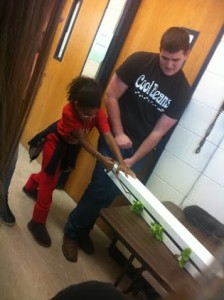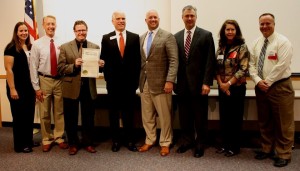You can help students impact their community.
And Mr. Jay Super can show you how.
The world of soil-less science is an exciting one. In fact, I find myself getting more and more excited about it everyday.
Today I bring you the story of one amazing educator who is taking school hydroponics further than ever before. He is showing the educational community (and in fact his entire community) that the applications for hydroponics are endless. And he’s only begun to skim the surface.
Passion: Pass it on.
Have you ever been having a conversation with someone who is just beaming with happiness, and suddenly you find yourself smiling right along with them, even though you started out with no interest in whatever they were talking about? Or on the flip side, have you ever left a solemn conversation suddenly feeling as depressed as the speaker?
It’s no question that other people’s emotions wear off on us, without us even realizing it. In fact, there have been thousands of physiological studies behind this concept know as the emotional contagion theory (check out Wikipedia for more information).
I believe it is this phenomena that makes Mr. Jay Super’s teaching philosophy so effective and influential.
Jay believes in hands-on and passionate learning. And because of emotional contagion, passionate learning is best developed through truly passionate teaching.
To Jay, passion in teaching means exposing students to concepts in an experiential way and letting them get their hands dirty.
Students have to be passionate about what they are learning. Without passion, students will never strive to learn more, to get involved, or to carry what they have learned into the real world for the long term.
 Who is Jay Super?
Who is Jay Super?
Jay received his BS in Systematics and Ecology (biology) from Kansas University. Then, he returned to Wichita and earned his BA in Secondary Education. Mr. Super taught life science (biology, zoology, and botany) for 17 years, until two years ago when he was introduced to the possibility of becoming an ag teacher.
Now he has one foot in the door with ag and one foot in biology, and will be taking on the addition of horticulture next year, which he says is “a perfect combination of the two.”
He is loving teaching more than ever, happily and passionately introducing students to a vast array of new opportunities through modern agriculture.
A new generation of world citizens.
After one conversation with Jay, it is apparent that his passion for agriculture is deep-seated and infectious. He is assembling an army of passionate young minds, looking to go out into the world and take on sustainability, world food insecurity, and socioeconomic development through modern agricultural methods like hydroponics.
If you have a passion for it, that rubs off and makes all the difference in the world…I show them how excited I am about it…and then they get excited about it!
It is education like this that will cultivate the next generation of forward-thinking producers paired with educated consumers, in a world where this harmony is so badly needed.
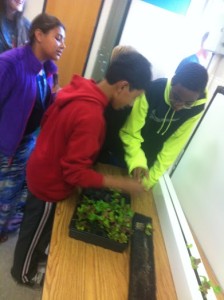 Kids are paying attention. They see things on the news about GMO and organic. They actually do want to know about where their food is coming from.
Kids are paying attention. They see things on the news about GMO and organic. They actually do want to know about where their food is coming from.
Roughly 90 percent of the students in Mr. Supers’ school come from the city or other urban areas. Although Kansas is host to some of the largest agricultural operations in the United States, many of its urban inhabitants still have no modern understanding of agriculture or where food comes from (as is true for every other state).
But as more and more health trends and health concerns surface, it’s becoming increasingly important for people to learn about what they are consuming, so that they can make educated decisions, rather than consuming products blindly.
This is just one of the topics Mr. Super focuses on in his hydroponic lessons in order to help close this knowledge gap between consumers and their food.
The road to (hallway) hydroponics
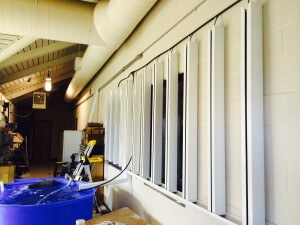
Let’s back up. How did Jay Super get started with hydroponics, anyway?
 Two years ago, Mr. Super’s school (Maize High School) received a KDA Farm to School Sub-grant to develop a “student managed food production system to service a minimum of two locally produced food items in the school cafeteria any five months during the school year.” Similar to Laramie, most of the school year in Maize takes place in the winter. As a result many of the schools decided that hydroponics would be the best way to grow produce for their school cafeterias.
Two years ago, Mr. Super’s school (Maize High School) received a KDA Farm to School Sub-grant to develop a “student managed food production system to service a minimum of two locally produced food items in the school cafeteria any five months during the school year.” Similar to Laramie, most of the school year in Maize takes place in the winter. As a result many of the schools decided that hydroponics would be the best way to grow produce for their school cafeterias.
Up to this point, Jays only experience with hydroponics had been at Disney World’s “Living with the Land” Epcot Attraction. Intrigued by the idea, he began researching hydroponic options.
Word got around, and soon Jay was approached by a fellow teacher, John Albin, who had recently quit conventional farming methods in order to become a sustainable grower and get into hydroponics. According to Jay, John had been testing out a few different things, including ZipGrow towers.
[He] said you have to get them!… That’s how I got involved. By far they worked better than anything else we have tried, they produce way more, are a lot easier and are just great.
Mr. Super uses a ZipGrow system in the school’s hallway as an enrichment tool for the school and the community in five different ways- and it is making a BIG impact.
- Augmenting agriculture, science, and culinary classes
- Fostering positive relationships between students of all ages
- Feeding students in the school
- Encouraging leadership qualities in students
- Creating lasting community relationships
Read about each of these uses below.
Augmenting agriculture, science, and culinary classes
Educational hydroponics does not have to be limited to the classroom. Maize High School is a great example of this.
Mr. Super is becoming an educational hydroponics connoisseur as he now heads up the use of hydroponics for several different applications at the high school, middle school, and more, using his well-designed self-made green wall in one of the school’s hallways, thanks to the assistance of fellow educator John Albin.
Inside the classroom, Mr. Super teaches several classes which implement, or will be implementing studies with the hydroponic ZipGrow towers including Intro to Agriculture, Plant and Animal Science, and a future Horticulture class.
Outside of this, he also works with the school’s culinary class to provide freshly grown hydroponic produce for use in their culinary studies. In addition, he also advises 75 students in the Maize FFA chapter, providing hydroponic options for SAEs, or Supervised Agricultural Experiences (check back for a future post on Hydroponics and FFA).
It doesn’t stop there. Jay and his students host tours and school functions which get the community involved and helps educate an adult audience as well.
Fostering positive relationships between students of all ages
In addition to his other applications, Mr. Super hosts a mentor program for nearby Maize South Middle School which offers a three-part hydroponic learning experience called Germinating. Growing. Harvesting. This program helps foster positive relationships between younger and older students, while igniting a fire for sustainable agriculture in the hearts of incoming students.
“We just had a group of 6th graders come over last week, and started teaching them about what we’ve learned so far with hydroponics, focus[ing] on NPK…
The older kids are really getting the younger kids excited. It’s really neat to see the relationships of the students.”
Here’s the program break-down:
- Visit #1: Students planted lettuce plugs for use in the hydroponic system, as well as corn and sunflower cups for the raised beds.
- Visit #2: The high school students helped the middle schoolers transplant the seedling plugs into the ZipGrow towers.
- Visit #3: The students will harvest the lettuce right off the wall and have lunch together, in which they will have a selection of dressings and other salad fixings to create their own fresh salads.
Maize South Middle School teacher had kind words to share with Mr.Super after their first visit:
“My students have benefited greatly from the opportunity to visit Maize High School’s hydroponic garden and agriculture program. Students were able to see real life application of many of the Biology concepts they are currently studying; including limiting factors and symbiotic relationships. Students were also able to learn about what agriculture in Kansas is all about.” -Darcie Lowry
Teaching hydroponics to younger students is a wonderful way to establish a strong foundation for more challenging STEM concepts they will see later in their academic careers. Hydroponics can be taught to any age group, but it is even better when it develops healthy relationships between grade levels, helping to minimize conflicts like bullying later on. It also helps students draw connections between what they are learning in class, and the real world. All of which are amazing benefits.
So hydroponics can teach students. But can it feed them?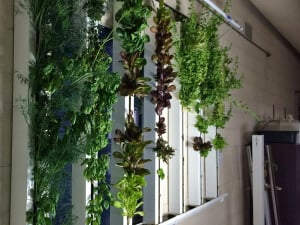
Jays hydroponic system of ZipGrow towers is not just only feeding the minds of his students, it is feeding their bellies.
As part of the grant, the system must be used to produce food for the school cafeteria. One of Jays biggest fears going into this was that he wanted to be able to grow enough produce for one lunch period throughout the school year, but he wondered, how much food can you really produce hydroponically?
As it turns out, Jay was able to produce more than he ever expected.
We produce enough to produce enough salad for one lunch period with just 8 towers…You can go from seed to harvesting some types of lettuce in maybe 4 weeks.
Amazed by how much he and the students were able to produce hydroponically in ZipGrow towers, Jay now hopes to grow all of the lettuce for the entire cafeteria, and has plans to expand into a greenhouse if awarded the funding.
Encouraging leadership qualities in students
Jay’s hydroponics program has become highly recognized over the past year. In fact, the program’s impressive performance went above and beyond the terms of the Farm to School grant and earned so much recognition that the Kansas Department of Ag decided to kick off Farm to School Month with a showcase at Maize High School on October 6th earlier this school year.
Representatives from the Maize Board of Education, Kansas Department of Agriculture, Kansas Department of Education, and members of the U.S. Department of Agriculture Food and Nutrition Services Farm to School Committee attended the event, as well as members of the press.
During this highly renowned event, the school’s culinary program linked up with Mr. Super to provide a catered lunch for the prestigious attendees. They used some fresh greens from Mr.Super’s hydroponic system, and locally sourced the rest of their ingredients to make a wonderful student-made meal for their visitors.
Gaining recognition once more, Maize High School received a visit request from the National Director of the School Lunch Program. She, her entourage, and her press agent spent the whole afternoon touring at the school and checking out the hydroponics system.
As a part of this, the school’s BPA (Business Professionals of America) students had the chance to visit with and interview the director and the other attendees. This provided the students with a first-hand opportunity to make connections between what they were learning, and their futures.
Creating lasting community relationships
 Mr.Super’s hydroponics hallway is not just creating a lasting impression on national representatives, but also on the local community members as well.
Mr.Super’s hydroponics hallway is not just creating a lasting impression on national representatives, but also on the local community members as well.
This year, Maize High School also hosted a Food Program Tour with the Kansas Leadership Foundation Healthy Food Initiative. This initiative partners with the Kansas Heart Association, Wichita Neighborhood Association, IMA Insurance Group, Sedgwick County Health Department, and other private organizations in hopes to increase healthy eating and make connections with small businesses to help improve opportunities for eating healthy in the community.
The ag students formed lasting relationships with the visitors, and have now grown food for the Wichita Neighborhood Association’s community garden. As a result, these students and the school have made a direct connection with the inner city community.
Now Mr. Super’s students do not just have a better understanding of where their food comes from and how urban ag works, but they are living it and using it to create a healthier community.
High school hydroponics making waves and opening doors
Mr. Jay Super is doing great things for the future of sustainable agriculture in schools, and is making great leaps in providing recognition and funding for others looking to implement school hydroponics or aquaponics systems.
His passion for agriculture is infectious, and has led to some pretty amazing results inside and outside of the classroom. Like a drop of water in the ocean, Jay’s actions in teaching school hydroponics with ZipGrow towers started out small, and is now sending out massive waves. He is paving the way for bright futures for students of all ages, backgrounds and interests, as well as opening the doors for other schools to follow the pursuit of modern sustainable agriculture through soil-less science. Mr. Jay Super is truly inspiring.
If you are an educator looking for funding opportunities, I recommend that you check out your options with your local Farm to School programs and our Top 10 Funding Opportunities and Grants for Schools post. Meanwhile, Bright Agrotech will continue to scout and champion for new funding opportunities and grants for innovative educators looking to use soil-less science in their schools.
Now, just look at the amazing things Mr. Jay Super has done with just eight towers and a diverse group of passionate students. Imagine what you could achieve with your students! To get the conversation started, check out our Nutriet Cycling Discussion Plan, and then ask yourself…does your school have what it takes to be the next big name in educational hydroponics?

